Historic towns of the Sukhothai Kingdom

Historic Towns of the Sukhothai Kingdom
Two locations close to Sukhothai that form part of the same group of UNESCO World Heritage sites are Si Satchanalai and the town of Kamphaeng Phet. For dedicated history buffs, both are worth a visit but for the casual visitor, the latter is probably only worth it if you are passing anyway. Si Satchanalai on the other hand is somewhat off the beaten path but its ancient ruins set amidst ancient trees are well worth a visit.
The historical park is about sixty kilometres north of Sukhothai and, unless you have your own transport, is rather a nuisance to get to. Because of that visitors are few and far between. On the day I went, I saw only three others along with a handful of gardeners and two monks.
There are about three buses a day leaving from New Sukhothai bus terminal which pass along route 101. Get off at the entrance to Wat Phra Si Rattana Mahathat Chaliang, between Sois Thetsaban 24 & 26. There is a little shop by the entrance to the temple where bicycles may be rented. Proceed through the gate into the temple grounds and over the wooden suspension bridge into Chaliang.
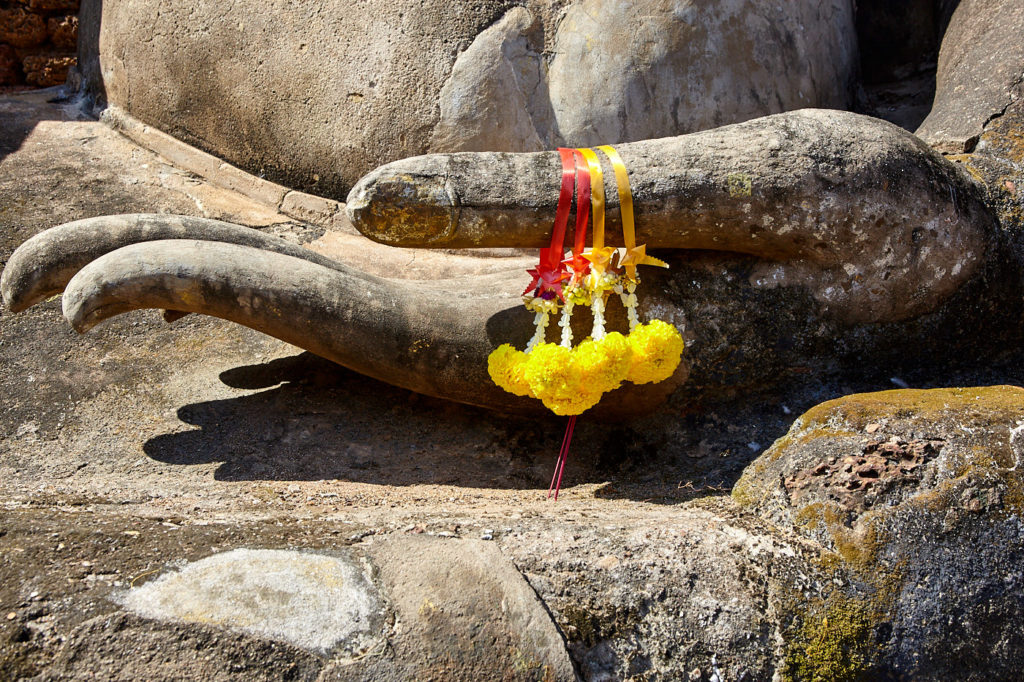
Detail of the Buddha image at Wat Phra Si Ratana Mahathat in Chaliang
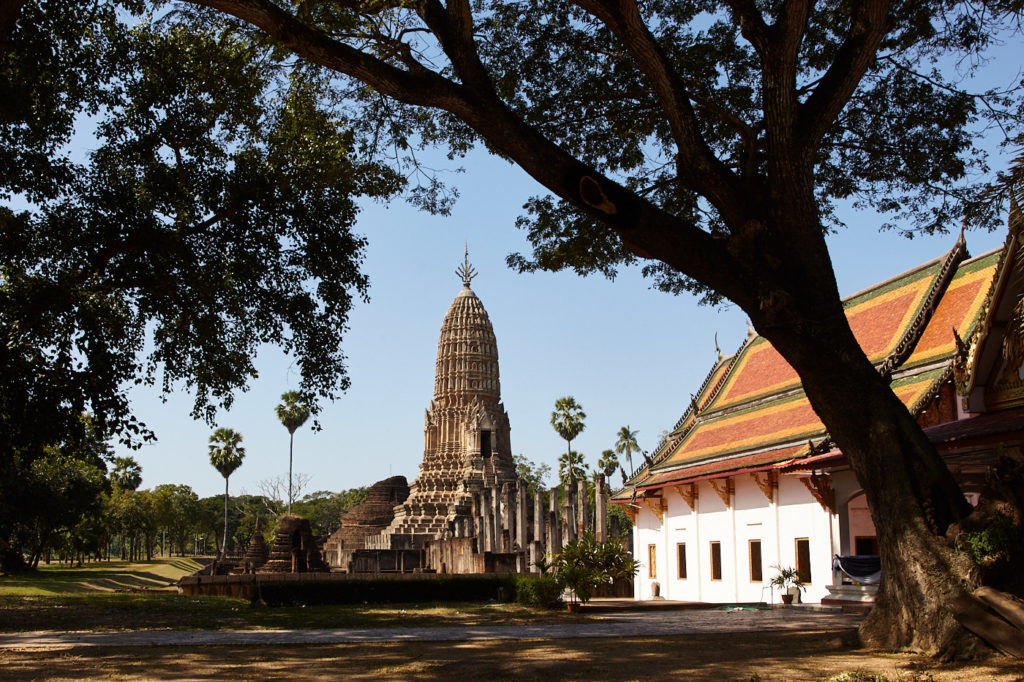
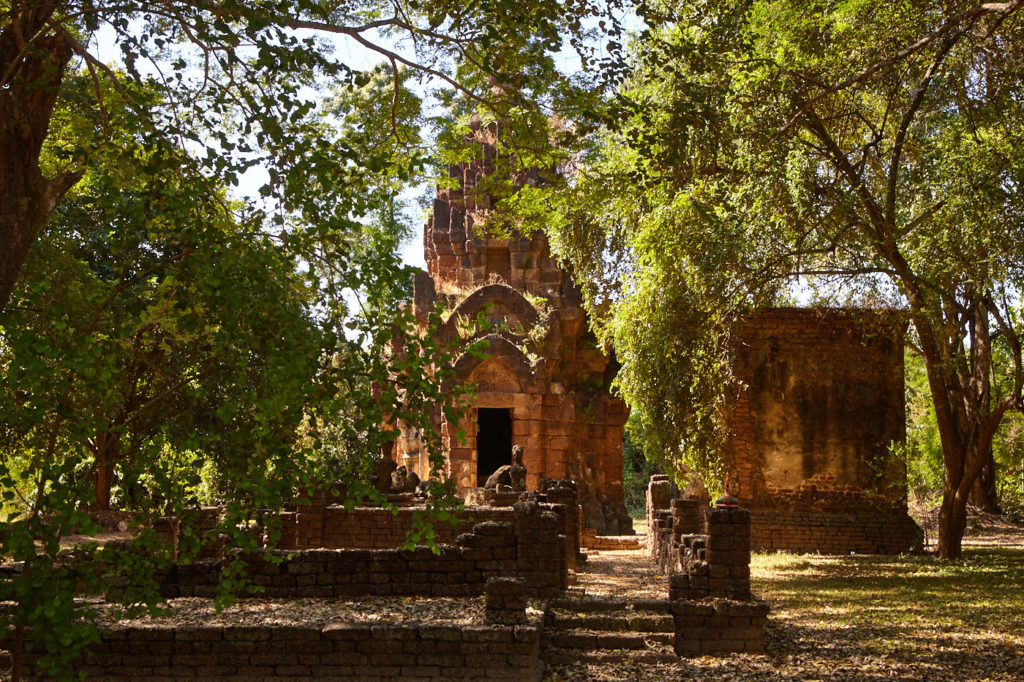
The original Khmer-style prang of Wat Phra Si Ratana Mahathat was redesigned in the eighteenth century (left). The Bayon-style tower of Wat Chao Chan.
There had been a settlement at Chaliang as far back as the 11th century. The name means City of Water and it is indeed sandwiched on both sides by the Yom River. The river itself loops back around a couple of fields a little to the east. It had been the northernmost outpost of the Khmer empire but when Sukhothai broke free from Angkor’s yoke in 1239 it came under the control of the new kingdom.
See also: Sukhothai, the cradle of Thai civilisation
The most important temple here is Wat Phra Si Ratana Mahathat. Built in the late twelfth century during the reign of Khmer ruler Jayavarman VII. It features a large Khmer-style prang originally built in the style of the Bayon at Angkor but redesigned in Ayutthaya style during the eighteenth century. The gate is decorated with bas-reliefs including a Brahma head facing four directions.
Another interesting structure at Chaliang is the prasat at Wat Chao Chan. The Bayon-style tower which was built in the late twelfth century still attracts devotees who place Buddha images and incense sticks on alters within the tower. It is thought that the temple was built on the site of an even older temple dating back to the Dvaravati period, which began in the sixth century.
Si Satchanalai
Si Satchanalai Park itself is three kilometres east of Chaliang sheltered by a line of low hills along its northern edge. It was founded in 1250 as the Sukhothai kingdom’s second city and residence of the Crown Prince. It became an important centre of porcelain production with exports as far afield as Japan and Indonesia.

Wat Chedi Chet Thaeo

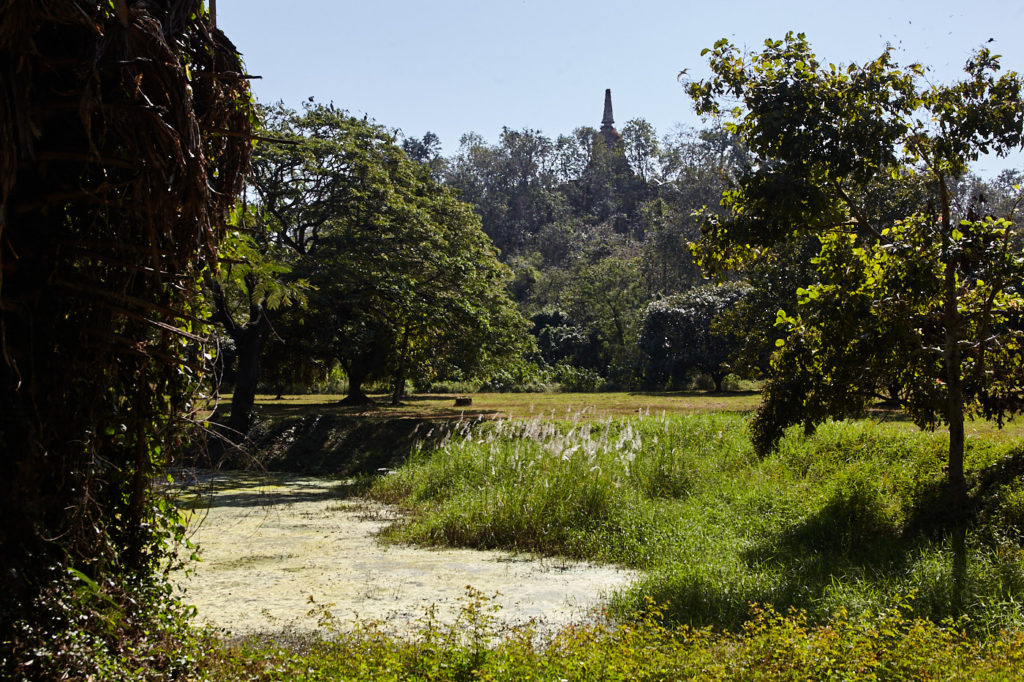
A monk takes in the peaceful surroundings at Si Satchanalai Historical Park
Although Sukhothai’s slow decline began shortly after the death of Ramkhamhaeng, Si Satchanalai was able to maintain its commercial position despite being annexed by the Lanna kingdom and later by Ayutthaya. The city was eventually destroyed by the Burmese army in 1766.
Motor vehicles are not allowed in the main park area, bicycle or foot is the only way to get around. Trees are abundant, the pathways are well shaded and the only sound to break the silence is the rather spooky hoo-hoo-hoo call of the greater coucal. A bird that is often associated with spirits and omens.
The two major temples in the park are Wat Chedi Chet Thaeo and Wat Chang Lom (main picture). Both are located in the centre of the park. The former, built around 1340, is unique among temples of the period as it features a main lotus leaf style chedi surrounded by 32 smaller chedis of varying styles from Sri Lanka, Lanna and Bagan. Because of its size and location, it is believed that this was a royal temple and burial place for members of the ruling family. The temple is surrounded by a moat and wall, shattered in places by the roots of old banyan trees.

Wat Khao Phanom Phloeng. The name translates as Holy Fire Mountain temple. It was named thus after a hermit told a local chieftain that the place was to be used for fire ceremonies.
Wat Chang Lom was commissioned in 1285 by Ramkhamhaeng after he had found relics of the Buddha at the site. After paying homage to them the King reburied the relics and had a chedi built over them. Around the square base of the Chedi are 39 laterite elephants, eight along the east side, and nine along the others with a crowned elephant at each corner. The elephants have suffered the ravages of time, originally they would have been covered with carved stucco. From a distance, it would have looked as if the elephants were supporting the entire Chedi on their backs. An illusion that is still discernable even to this day.
Wat Khao Phanom Phloeng and Wat Khao Suwan Khiri sit on top of the two hills at the northern end of the park. A stairway to the north of Wat Chang Lom leads to Wat Khao Phanom Phloeng. Here there is a large seated Buddha and a mandapa which houses a shrine to the local deity Chao Mae La Ong Sam Lee. Behind the mandapa, there is a trail that leads through the forest to Wat Khao Suwan Khiri on the next hill.
Both of the hills are nesting grounds for thousands of Asian openbill storks who make a lot of noise and a considerable mess.
Kamphaeng Phet
There are two zones at Kamphaeng Phet the forest monasteries, or Khet Aranyik, are about a kilometre north of the town along Route 101.
There are about forty sites spread across a large area of forest. But with the exception of perhaps Wat Chang Rob, which sits on the highest point with its Sri Lankan style chedi and base of elephant sculptures, the area is best taken as a whole and enjoyed as a place to wander and contemplate or simply to sit awhile and enjoy the tranquil surroundings.
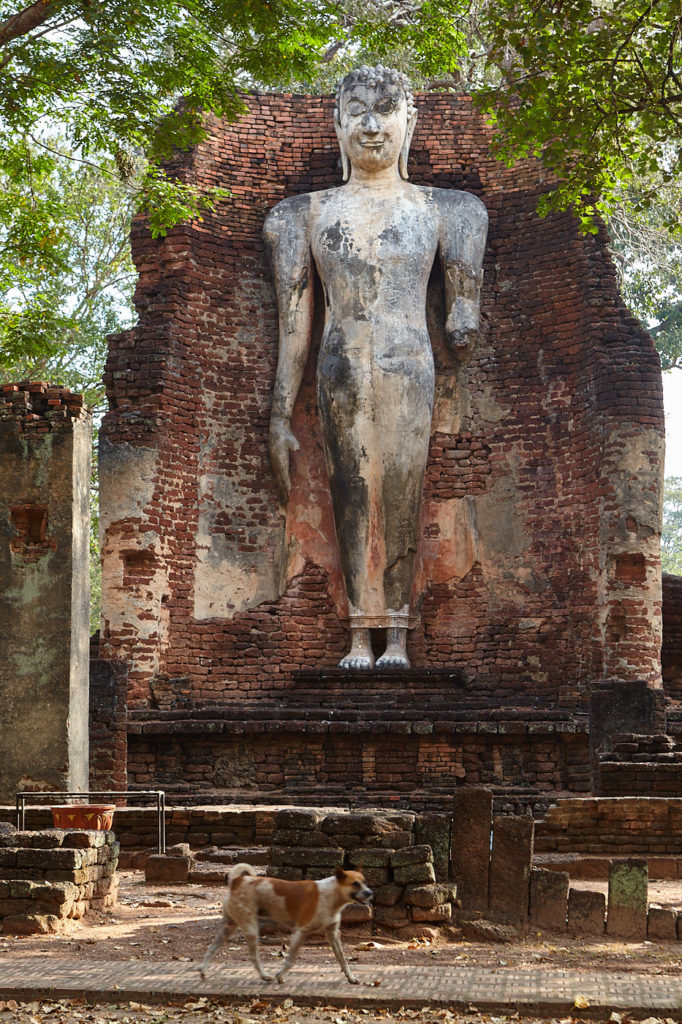

Standing Buddha in the Mandapa at Wat Phra Si Iriyabot, one of the temples in the forest zone (left). Chedi at Wat Phra Kaeo.
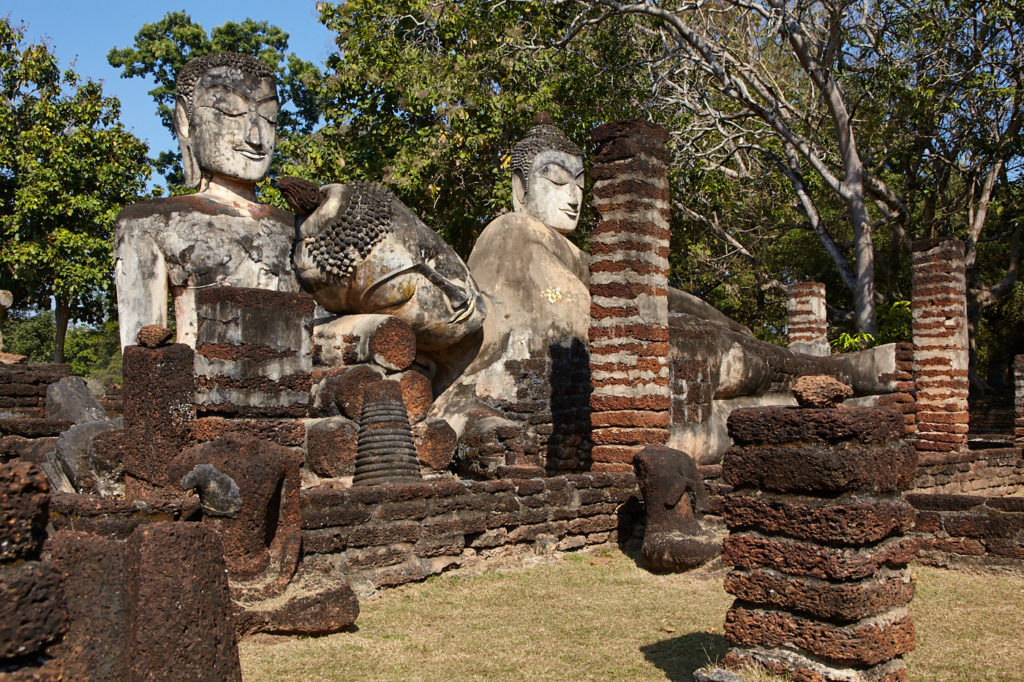
Ayutthaya-style Buddhas at Wat Phra Kaeo in Kamphaeng Phet
The inner city site boasts only Wat Phra That, Wat Phra Kaeo and the city pillar shrine. Together they occupy a 750-metre strip of land between Rachadumnoen 2 Road and Soi Pindumri with the entrance at the east. The main feature of Wat Phra That is the large, fifteenth-century chedi, which once housed relics of the Buddha.
Directly behind is Wat Phra Kaeo which was built in the 15th century to house the nation’s most revered Buddha image which now resides in Bangkok. It is believed the construction of the temple spanned several hundred years since the structures feature both Sukhothai and Ayutthaya styles. There are a number of laterite Buddha images that are so weather-worn they almost look like modern art while, behind the principal chedi, there is a viharn with three very well-preserved Ayutthaya-style Buddhas. Two of them are sitting in the subduing Mara position while the one in front is reclining.
The city pillar shrine is behind Wat Phra Kaeo. The existing shrine was opened in 1984 and if you’re lucky there will be a Likay performance, a form of popular folk theatre, in progress.